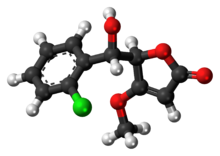Losigamone
 | |
 | |
| Clinical data | |
|---|---|
| ATC code |
|
| Legal status | |
| Legal status |
|
| Identifiers | |
| |
| CAS Number | |
| PubChem CID | |
| ChemSpider | |
| UNII | |
| Chemical and physical data | |
| Formula | C12H11ClO4 |
| Molar mass | 254.67 g·mol−1 |
| 3D model (JSmol) | |
| |
| |
| | |
Losigamone (INN) is an investigational drug for the treatment of epilepsy. It has been studied as an add-on treatment for partial seizures.[1] Phase III clinical trials were conducted around the year 2000.[2]
Mechanism of action
The mechanism of action is not known. Data regarding the interaction of losigamone with GABA receptors are inconsistent: it increases GABA-induced chloride influx in spinal cord neuron cultures, but has no significant influence on GABAergic inhibitory postsynaptic potentials in hippocampal slices.[2] Interaction with potassium[2] and sodium channels[3] has been proposed. Results from both in vitro and in vivo experiments confirm that the pharmacological activity profiles of the two losigamone enantiomers are not identical and suggest further that excitatory amino acid-mediated processes are involved in the mode of action of (+)-losigamone (the compound shown in the image) whereas (–)-losigamone does not possess such properties.[4]
References
- ^ Baulac M, Klement S (August 2003). "Efficacy and safety of Losigamone in partial seizures: a randomized double-blind study". Epilepsy Research. 55 (3): 177–89. doi:10.1016/S0920-1211(03)00108-6. PMID 12972172. S2CID 25270336.
- ^ a b c Willmore LJ (December 2001). "Losigamone. Dr Willmar Schwabe". Current Opinion in Investigational Drugs. 2 (12): 1763–6. PMID 11892943.
- ^ Draguhn A, Jungclaus M, Sokolowa S, Heinemann U (May 1997). "Losigamone decreases spontaneous synaptic activity in cultured hippocampal neurons". European Journal of Pharmacology. 325 (2–3): 245–51. doi:10.1016/S0014-2999(97)00121-0. PMID 9163572.
- ^ Jones FA, Davies JA (November 1999). "The anticonvulsant effects of the enantiomers of losigamone". British Journal of Pharmacology. 128 (6): 1223–8. doi:10.1038/sj.bjp.0702919. PMC 1571758. PMID 10578135.
